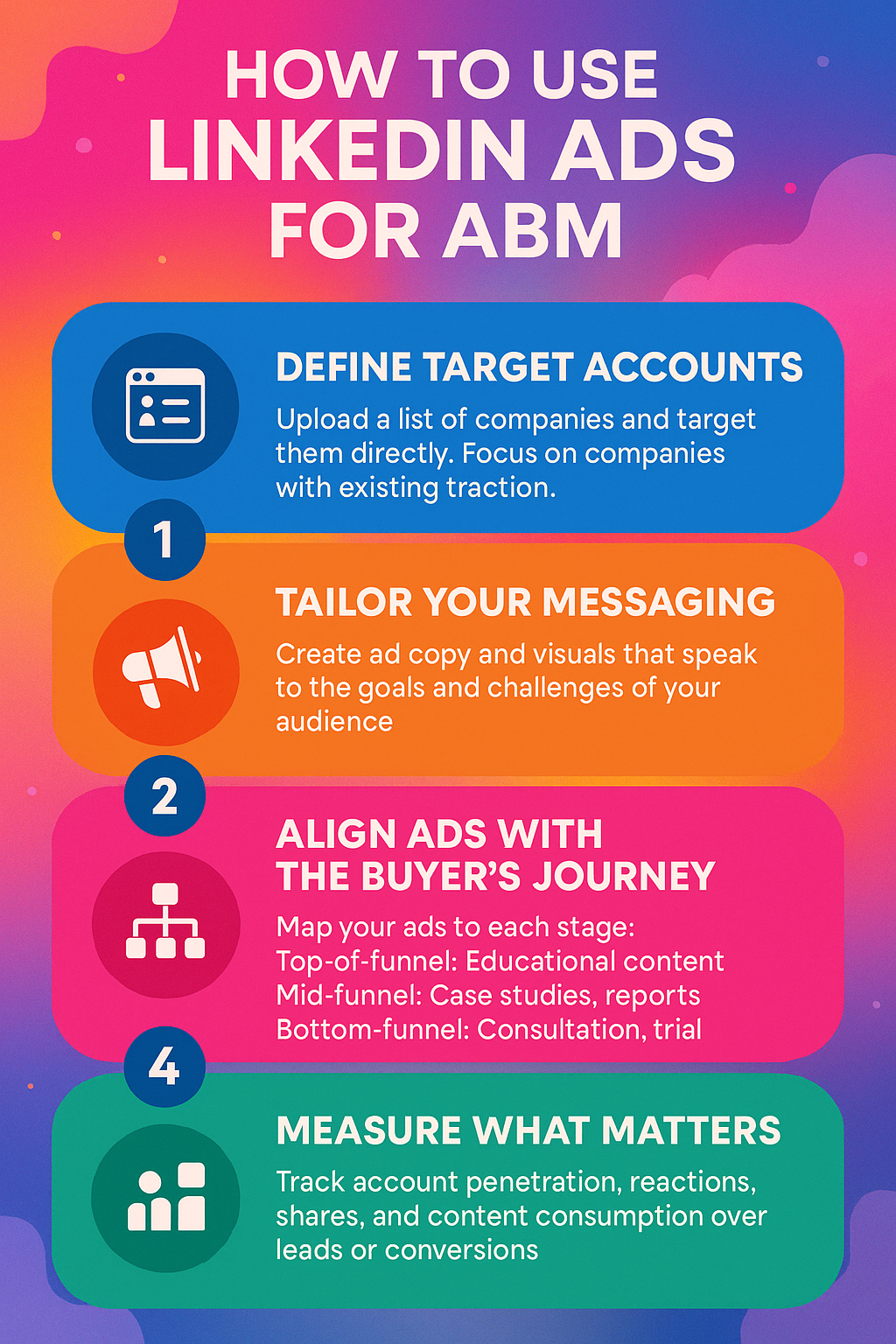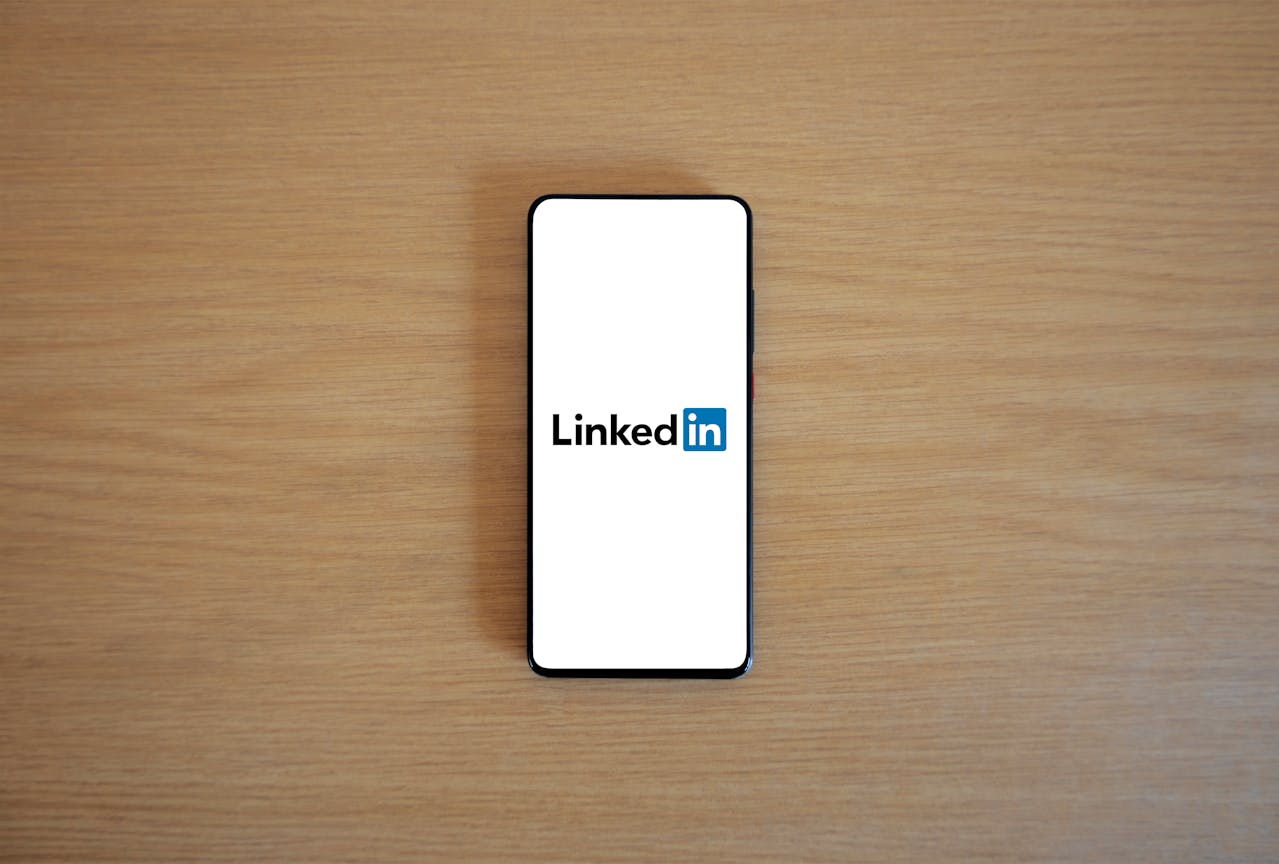Account-Based Marketing (ABM) is no longer a fringe strategy—it’s the cornerstone of high-performing B2B programs. And while there are many tools that can help execute ABM, LinkedIn Ads stands out as one of the most powerful and precise channels for targeting high-value accounts.
Why? Because LinkedIn has what other platforms don’t: a massive database of professional identity data, paired with rich targeting capabilities across companies, job titles, industries, and even intent behaviors.
But simply launching LinkedIn Ads to your account list isn’t enough. To turn engagement into pipeline, your execution must be intentional, relevant, and personalized to the buyer journey.
In this post, we’ll walk through how to use LinkedIn Ads for ABM—from targeting to messaging to measurement—and how to turn it into a high-performing part of your revenue strategy.

Why LinkedIn Ads and ABM Are a Natural Fit
Let’s start with the basics: LinkedIn Ads is one of the most effective platforms to support account-based marketing efforts because of how accurately it allows you to reach decision-makers at specific companies.
Most B2B buying cycles involve multiple stakeholders. With LinkedIn Ads, you can:
- Upload a curated list of target accounts
- Layer job function, seniority, and title targeting
- Personalize ad content based on role or buyer stage
- See engagement data broken down by company
It’s the rare ad platform that allows both company-level precision and job role nuance—and that’s why it’s ideal for ABM.
Step 1: Define and Upload Your Target Account List
Every good ABM program starts with a well-researched, prioritized list of target accounts.
On LinkedIn, this means preparing and uploading a matched audience list of companies that meet your ideal customer profile (ICP). You can build this from:
- CRM data (closed-won analysis, active opportunities)
- Product usage data (existing users ready for expansion)
- Intent data (Bombora, 6sense, or G2 signals)
- Manual research or strategic prioritization
Pro tip: Focus on companies where you already have some traction. This might include prior website engagement, email opens, or existing sales conversations.
Once uploaded, LinkedIn will match these accounts to its internal company profiles. You can then layer additional filters—like job titles or departments—to ensure you’re reaching the right people within each organization.
Step 2: Tailor Messaging to Each Segment
ABM is about relevance. The more aligned your ad creative is to the prospect’s reality, the more likely they are to engage.
On LinkedIn, where users scroll through thought leadership, hiring updates, and news, your ads need to stand out without feeling like ads.
Here’s how to personalize effectively:
- By company: Reference industry-specific pains or known goals of your top accounts.
- By role: A CFO and a Head of Operations care about different outcomes. Speak to each audience’s unique motivators.
- By stage: Serve high-level content to unaware accounts and bottom-funnel asks to accounts that have already engaged.
Examples of tailored messaging:
- “Struggling to reduce fulfillment costs across your distribution network?” (Ops role)
- “How [COMPANY NAME] reduced churn by 22% using a modern data stack.” (case study for mid-funnel)
- “Considering a switch in your procurement platform? Here’s what to evaluate.” (bottom-funnel)
Even subtle tweaks in ad copy, CTA, or creative can boost engagement significantly when aligned with account needs.
Step 3: Map Ads to the Buyer Journey
LinkedIn Ads for ABM works best when you treat it as a multi-stage engagement strategy, not a one-and-done lead gen tactic.
Think of your ad strategy in three stages:
Top of Funnel (Awareness)
Goal: Generate brand recognition and build problem awareness.
Use:
- Thought leadership articles
- Educational blog posts
- Industry benchmark reports
- Short explainer videos
These ads should give value, not ask for it. You’re earning attention.
Mid Funnel (Consideration)
Goal: Reinforce credibility and spark active interest.
Use:
- Case studies
- Webinar replays
- Product comparisons
- Gated research reports
At this stage, show how you solve specific pain points—and that companies like them already trust you.
Bottom of Funnel (Decision)
Goal: Drive action from warm accounts already engaging with your brand.
Use:
- Free trial offers
- Demo requests
- ROI calculators
- Consultations or audits
Make it clear: your solution is proven, specific, and ready to go.
The power of LinkedIn Ads lies in its ability to sequence these touchpoints to the right stakeholders over time, reinforcing your brand and value proposition.
Step 4: Measure ABM Performance Differently
One of the biggest mistakes marketers make with LinkedIn Ads and ABM is only tracking lead volume or cost per lead.
But ABM isn’t about volume—it’s about penetration and progression within your target accounts.
Metrics to focus on:
- Account penetration: How many contacts from each account have seen or engaged with your ads?
- Engagement quality: Are key decision-makers reacting, commenting, or clicking?
- Content consumption: Are they downloading reports, watching videos, or returning to your site?
- Sales integration: Are those accounts moving forward in the sales process?
Some of the best ABM campaigns may not result in an immediate lead form submission. But if they generate brand awareness, stakeholder consensus, and positive conversations, they’re doing their job.
Use LinkedIn’s native reporting tools or integrate with platforms like HubSpot, Salesforce, or Dreamdata to attribute ad engagement to pipeline more accurately.
Advanced Tip: Personalize by Buying Committee
Want to go a level deeper?
Use LinkedIn Ads to create parallel ad campaigns for different roles in the buying committee.
For example:
- Marketing persona: Show a campaign with creative around brand growth and campaign efficiency.
- Finance persona: Highlight ROI, spend efficiency, and cost-saving outcomes.
- IT persona: Focus on ease of integration, security, and low technical lift.
This builds consensus across stakeholders—and ensures no one in the buying process feels ignored.
Final Thoughts: LinkedIn Ads + ABM Is a Strategic Power Move
In 2025, running LinkedIn Ads without an ABM strategy is like fishing without a net.
You might get a bite, but you’ll waste a lot of effort casting too wide.
By focusing on target accounts, personalizing messaging, aligning to the buyer journey, and measuring deeper engagement—not just conversions—you can turn LinkedIn Ads into a high-ROI driver of real pipeline.
So if you’re already investing in ABM, LinkedIn Ads is one of your best levers to scale it.
The targeting is unmatched. The buying signals are real. And the results compound when done right.

Hi there! I’m Scott, and I am the principal consultant and thought leader behind Stratus Analytics. I have a Master of Science degree in marketing analytics, and I’ve have been providing freelance digital marketing services for over 20 years. Additionally, I have written several books on marketing which you can find here on Amazon or this website.
DISCLAIMER: Due to my work in the packaging industry, I cannot take on freelance clients within the packaging manufacturing space. I do not want to provide disservice to your vision or my employer. Thank you for understanding.
